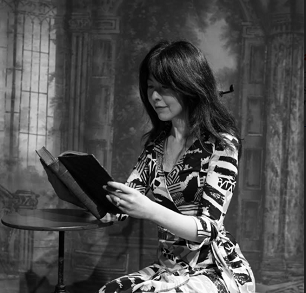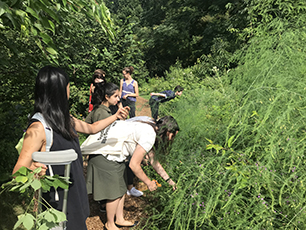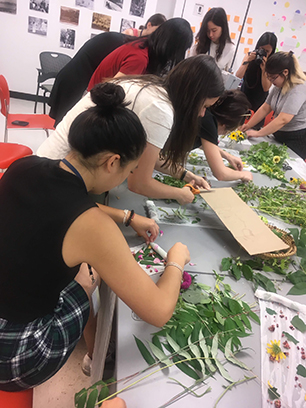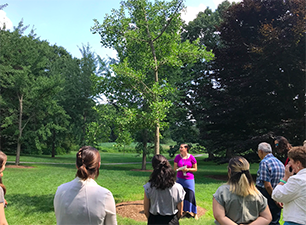From the Fellow: Connecting to a Sense of Place through the Intersection of Art and Ecology
By Arthurina Fears, Curator of Education and Programs, Davis Museum at Wellesley College

Arthurina Fears (she/her) is the 2020/21 NEMA Fellow. As part of the fellowship Arthurina is writing a series of articles for the NEMA community.
As museums transition from virtual to hybrid and in-person programs, there is an increasing need for a sense of connection and community. Eager to emerge from behind computer screens, video cameras, and microphones, there is greater desire for in-person, experiential moments, and a need to return to some sense, or degree, of normalcy.
What would happen if we consider the landscape, as a sense of place, to these experiences? How might examining or reframing our relationship to nature contribute to a sense of connection?
Throughout this time, more museums with access to outdoor spaces have explored physically-distanced outdoor experiences, but many institutions already had well-established and ongoing outdoor programs in place, including yoga, sculpture tours, and art making workshops. These outdoor activities continue to be in demand as more museum visitors are seeking tactile and grounding encounters with objects and nature, from personal enrichment to shared, social experiences with friends and family.
Another outdoor experience that some museums and botanical gardens have offered is “forest bathing.” In the book, Forest Bathing: How Trees Can Help You Find Health and Happiness, Dr. Qing Li, Chairman of the Japanese Society for Forest Medicine, discusses the Japanese art and science of shinrin-yoku. Shinrin, or forest, and yoku, bath, translate as “forest bathing,” essentially “bathing in the forest atmosphere,” or a multisensory experience of nature.[1] Shinrin-yoku was first practiced in Japan in the 1980s initially as both part of a nature conservation campaign and the belief that being in nature has health benefits.[2] According to Li, there is some scientific evidence backing this assertion in that trees emit aromatherapeutic substances, phytoncides, which have demonstrated positive effects on the immune system, including lowered stress levels.[3]
How might we connect the benefits of being in nature to art at our institutions? How can we help our audiences find a sense of place through an exploration of art and ecology? Spending time outdoors can often seem more accessible and approachable than visiting a museum, so how can the two be merged?
Over the past four years at the Davis, we have collaborated with Wellesley College’s Paulson Ecology of Place Initiative, which “inspires and prepares Wellesley College students across disciplines to engage with their natural environment and develop a sense of place on our iconic campus to enrich their academic experience, well-being, and community, and become change agents who cultivate sustainable landscapes and communities around the globe.” We have connected art to the landscape and to community connection, from experiencing the landscape through dyeing with natural materials from harvested plants, and our collaborations have also included a haiku workshop with the College’s Buddhist Chaplain after exploring the environmental themes of artist Isabella Kirkland’s Taxa series with a Student Guide.

Students harvesting plants from Wellesley College’s edible garden for a natural dye making workshop

Students participating in a natural dye making workshop with the Paulson Ecology of Place Initiative
Additionally, the student-created Bark & Metal outdoor sculpture and ecology program, has grown due to collaboration with the Paulson and the Wellesley College Botanic Gardens. Developed by four Wellesley students, now alumnae, Sharon Liu ’17, Virginia White ’17, Ningyi Xi ’17, and Charlotte Yu ’17, students learn about the connections between the ecosystems and outdoor art they pass by each day. For instance, the placement of the sculpture Mozart III by Kenneth Snelson, located between the academic quad and Science Center, is described as connecting the humanities and sciences, and is also discussed in relation to the nearby gingko trees. Audiences are then encouraged to reconsider their perception of the landscape.

Student-led Bark and Metal tour exploring Mozart III by Kenneth Snelson, in relation to nearby gingko trees

Student-led Bark and Metal tour exploring gingko trees
Suzanne Langridge, Director of the Paulson Ecology of Place Initiative, eloquently frames the importance of our ongoing work:
“Creating, experiencing, and connecting art and nature can create a sense of wonder, curiosity, joy and beauty for our community that can reduce stress and provide a sense of calm during difficult times. With the college landscape closed to much of our community over the past year, we found new ways to continue making connections to art, to each other, and to our landscapes. We created and shared land art from materials found in our landscapes across the globe and reflected on meaningful trees in our remote locations while connecting back to trees in the art collection at the Davis Museum. These experiences, whether in person or remote, continue to provide a thread of connection and a sense of place that we share not just on our landscape, but across the globe.“
When training our Student Guides and Student Visitor Assistants this past year, I encouraged the students to think about their relationship to the Wellesley landscape. With the students attending classes and training virtually, the physical connection to the environment was something greatly missed. Through our collaboration with the Paulson, students have learned about their interactions with the Wellesley landscape, thinking of a sense of place, which has made the Bark & Metal tours all the more personal and relevant to Wellesley students.
Spending time outdoors and in nature can be nostalgic, as well as a source of relaxation and calm. However, at the beginning, and months in, of the pandemic, there were multiple days, often week-long stretches, in which I never ventured outside. I was glued to the incessant demand of a digital reality, which blurred work-life balance for me, this constant being online. Still disconcerting is the fact that this was not unique to my own situation as I spoke with other museum professionals and college students who also had the same habits. However, when I did step away, it was refreshing to see sunlight, to feel the rush of the wind, and to hear the rustling of leaves in the trees. I began to notice little moments that I had taken for granted, and now I really take the time to spend time outdoors whenever I can.
Over the summer, I attended a plein-air pastel painting workshop at Fruitlands, my first time visiting. This was my first foray to a semblance of normalcy, and it felt nourishing to be in a scenic landscape, sitting in the soft grass, painting the distant hills. Also during the pandemic, I returned to ikebana, Japanese flower arranging, and I have been creating thematic, ephemeral floral arrangements in harmony with the changing seasons; I have learned more about botany, as well as the emotion or mood that can be conveyed.
Early this fall, I physically returned to the Davis after working from home since last March. I walked through the lush, green landscape at Wellesley College, and for the first time in a year and a half, I felt a sense of place. It was familiar, and it allowed for me to reflect on my sense of connection not only to my workplace but also to the environment.
For the first-year students, and even many sophomores, both the Davis and the Wellesley landscape are new to them. In building upon our collaboration on our Art and Wellness program with counselors from the College’s Stone Center Counseling Service, we are collaborating with the Paulson to integrate the landscape and ecology into the program for our campus community. Students have expressed a desire for outdoor art making activities and experiences, and we are working with our campus partners to create meaningful encounters between self, art, and nature.
As we physically return to our museums and re-orient ourselves, it is worth exploring ways to be physically grounded. If your institution does not have access to a natural area, is there a local park or garden with whom you could collaborate? Alternately, are there objects in your collections that might touch upon ecological themes and which you could develop prompts for museum audiences to complete offsite at a natural site of their choosing?
Connecting to a sense of place contributes to connection, community, and purpose, even more important now, for both our museum audiences and ourselves.
Image credit for Arthurina’s profile photo:
Photo taken by William Van Beckum, Visiting Lecturer in Art, and ARTS 108: Photography I students at Wellesley College, March 2020
[1] Forest Bathing: How Trees Can Help You Find Health and Happiness, Dr. Qing Li, Viking, 2018, page 12
[2] Forest Bathing: How Trees Can Help You Find Health and Happiness, Dr. Qing Li, Viking, 2018, page 58
[3] Effect of forest bathing trips on human immune function, Qing Li, Environ Health Prev Med. 2010 Jan; 15(1): 9–17. https://www.ncbi.nlm.nih.gov/pmc/articles/PMC2793341/